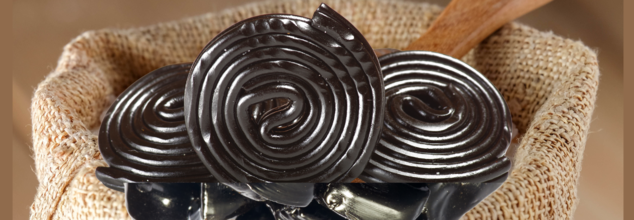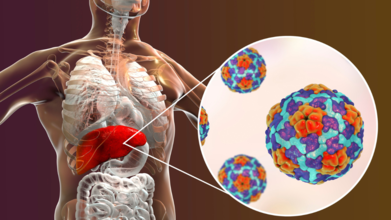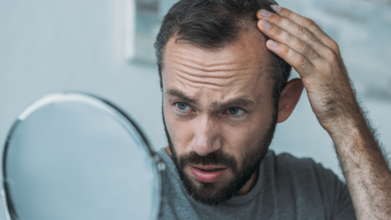- Health Conditions A-Z
- Health & Wellness
- Nutrition
- Fitness
- Health News
- Ayurveda
- Videos
- Medicine A-Z
- Parenting
- Web Stories
54-Year-Old Man’s Heart Stopped After Eating Too Much Licorice

A Massachusetts construction worker, aged 54, experienced a fatal cardiac arrest, and the killer was something most wouldn't expect—black licorice. The man was having dinner at a restaurant when he unexpectedly gasped, started trembling wildly, and lost consciousness. The emergency responders attended to him, gave him CPR, and administered medication to regulate his heartbeat. Though he regained consciousness for a short while, his condition worsened, and he died from multiorgan failure 32 hours after hospital admission.
What was interesting about this case was the cause. The gentleman had no other known medical condition that would have precipitated such a violent cardiac event. What was revealed through closer inspection of his diet was a shocking revelation: he had changed from eating fruit-flavored candy to eating black licorice and consumed one to two large packets daily for several weeks. His very high intake precipitated severely low potassium levels in his bloodstream, which arrested his heart.
Central to this medical puzzle is a substance within actual licorice known as glycyrrhizin. A naturally occurring inhibitor of an enzyme in the kidneys that helps regulate sodium, potassium, and water balance in the body, glycyrrhizin leads to sodium and water retention and potassium elimination—a mineral vital for healthy heart functioning—if taken in excess.
Low levels of potassium, or hypokalemia, can cause dangerous cardiac side effects, such as irregular heart rhythm, high blood pressure, and weakness in muscles, and even cardiac arrest in severe cases. The U.S. Food and Drug Administration (FDA) warns that eating even 2 ounces (56 grams) of black licorice every day for two weeks may lead to an irregular heart beat, especially for those above the age of 40 years.
How Much Licorice is Too Much?
Numerous individuals consume licorice-tasting candy with impunity, but all in moderation. The FDA only allows a content of 3.1% glycyrrhizic acid in foods, but the majority of licorice candies do not label the actual quantity they carry. This open lack of labeling might make it complicated for customers to estimate acceptable usage levels.
Dr. Neel Butala, a Massachusetts General Hospital cardiologist, pointed out that even small quantities of licorice might elevate blood pressure somewhat. Regular overconsumption, though—such as munching on a bag and a half per day, as in this instance—will substantially alter electrolyte balance and result in extreme health hazards.
Who is Most at Risk?
Although anyone with a high intake of black licorice is at risk of side effects, some populations are especially susceptible:
Adults above 40: Since metabolism and cardiovascular health vary with age, older people are more prone to the heart-related complications of licorice intake.
People with existing heart conditions: Those with hypertension, heart disease, or electrolyte disturbances should be particularly careful.
Individuals on certain medications: Licorice interacts adversely with diuretics, blood pressure drugs, corticosteroids, and certain other medications, worsening health conditions.
FDA Warnings and Medical Recommendations
The FDA warns consumers to watch out for black licorice consumption, especially over an extended period of time. The agency cautions that consuming even 2 ounces a day for two weeks might lead to hospitalization because of abnormal heart rhythms.
Here are precautions recommended by medical experts:
Check labels closely: Certain products of licorice include genuine glycyrrhizin, but others make use of anise oil, a flavor substitute, which carries no such threat.
Watch out for portion sizes: Infrequent intake in limited portions is safe most of the time, but one should stay away from it otherwise.
Keep watch for symptoms: If you develop dizziness, muscle weakness, irregular pulse, or swelling upon consuming licorice, then immediately visit the doctor.
Safer Alternatives to Black Licorice
For individuals who enjoy the flavor of licorice but prefer to be cautious about their health, safer alternatives are available:
Anise-flavored items: Numerous licorice-flavored sweets in the United States contain anise oil rather than actual licorice root.
Natural sweeteners: Choosing healthier snacks that contain natural sweeteners and flavors can assist in curbing the desire for high-sodium, high-sugar foods.
Balanced diets: Maintaining sufficient potassium levels through a diet high in bananas, spinach, avocados, and beans will counteract any slight loss of potassium from periodic licorice use.
Black licorice, when eaten in large amounts over time, can have life-threatening effects due to its ability to deplete potassium levels and disrupt heart function.
Hepatitis Day 2025: Is Hepatitis On A Decline Or Still A Cause Of Concern?

Credits: Canva
On World Hepatitis Day today, the spotlight is on one of the most misunderstood but critical public health challenges, viral hepatitis. Observed annually on July 28, this global awareness day focuses on liver inflammation that can silently progress into liver cirrhosis or cancer.
This year’s theme, “Hepatitis: Let’s Break It Down,” urges dismantling financial, social, and systemic barriers that prevent people from seeking testing, vaccination, and treatment.
The World Health Organization (WHO) continues to call for unified action to eliminate hepatitis as a public health threat by 2030.
But how far have we come in achieving that goal? A look at the data and expert insights reveals a mixed picture.
Hepatitis A on the Rise Among Adults
Traditionally associated with childhood jaundice, hepatitis A is now emerging as a more serious threat, especially in urban adults. Doctors in Mumbai report a rise in severe adult hepatitis A cases, including complications like liver failure. As hygiene standards improved in metros, fewer people were exposed to the virus in early childhood, leaving them without natural immunity. This means adults now face more aggressive symptoms when exposed through contaminated food or water, often during the monsoon season.
Pregnant women, too, are being impacted. In one case, a woman admitted for what appeared to be morning sickness was found to have hepatitis A. Doctors emphasize that hepatitis A can affect both mother and baby, and early diagnosis is crucial.
Hepatitis C Cases Drop Thanks to Free Treatment
There is, however, good news when it comes to hepatitis C. Since 2018, India’s National Viral Hepatitis Control Programme has made direct-acting antiviral treatments freely available. These drugs offer a full cure in just three months. As a result, new hepatitis C infections have declined significantly in both public and private hospitals.
In Maharashtra alone, over 28 lakh people were tested for hepatitis C in 2024-2025, out of which 9,476 tested positive. More than 2,000 people were started on treatment. Compared to 1,339 reported cases in 2021-2022, this rise in diagnosis doesn’t necessarily indicate more infections — instead, it reflects better testing and surveillance. Experts credit this progress to improved blood screening protocols and increased awareness around the dangers of needle sharing.
Hepatitis B Still a Serious Threat
Despite medical advancements, hepatitis B remains a major concern. Often referred to as one of the most infectious viruses, it affects millions and is known for its ability to stay dormant and reactivate. While it isn’t curable yet, it is manageable with long-term antiviral therapy. Unfortunately, lack of early symptoms means many people are diagnosed only when serious liver damage has already occurred.
Data from Maharashtra shows an alarming increase in hepatitis B cases, from 9,000 in 2021-2022 to 65,000 last year. This includes 23,000 pregnant women, highlighting the virus’s continued prevalence and risk of mother-to-child transmission. In some cases, patients have even required liver transplants due to delayed diagnosis and treatment.
Testing and Vaccination Are the Need of the Hour
Advances in diagnostics are changing the game. Portable machines like Truenat are making it easier to test for hepatitis viruses in remote areas. Maharashtra saw a 150% rise in hepatitis B testing and a fivefold increase in hepatitis C testing from 2023-24 to 2024-25. The central government is reportedly planning to install Truenat machines in all 40,000 primary health centres across the country in the next two years.
Vaccines for hepatitis A and B are available and effective, yet coverage remains uneven. Experts strongly advise vaccination for high-risk individuals and routine screening for hepatitis B surface antigen (HBsAg) and anti-HCV antibodies. These simple blood tests can be lifesaving when followed up with further tests to assess viral load.
Dr. Somnath Mukherjee, gastroenterologist at CMRI Kolkata, points out that hepatitis continues to be “one of the least understood global health challenges”, despite being preventable, treatable, and in some cases, curable.
He emphasizes the need to dismantle ignorance and stigma around testing and treatment. “World Hepatitis Day provides an opportunity to simplify awareness and dismantle barriers to infection awareness and elimination,” he says. His message is clear: Get tested. Get treated. Get protected.
Hepatitis 101
Hepatitis, caused by viruses labeled A through E, can often go unnoticed until significant liver damage has occurred. “Hepatitis B and C are the most dangerous,” explains Dr. Somnath Mukherjee, noting that these infections can silently progress to liver failure, cirrhosis, or even liver cancer if untreated.
While Hepatitis A and E typically spread through contaminated food or water—often in areas with poor sanitation—B and C are more commonly transmitted via unsafe blood transfusions, shared needles, or unprotected sex.
Symptoms, if they appear at all, might include fatigue, jaundice, dark urine, pale stools, abdominal swelling, or itching. “Waiting for symptoms is pointless,” he stresses, as most infections are asymptomatic.
The good news, however, is that hepatitis is preventable and treatable. Vaccines are available for Hepatitis A and B, and Hepatitis C is now curable with a three-month oral medication.
Though Hepatitis B isn’t curable yet, it is manageable with antiviral drugs. “Screening is crucial,” says Dr. Mukherjee, recommending simple blood tests like the Hepatitis B surface antigen (HBsAg) and Anti-HCV antibody, especially for those at higher risk.
Reusable Period Products May Not Be Safe, Study Finds Forever Chemicals In Feminine Hygiene Items

(Credit-Canva)
Feminine hygiene products' safety is a big thing. Even while manufacturing, these products must be handled with care because unsafe practices can lead to serious health issues. These products are used for the hygiene of intimate areas, and it is very easy to get infections and other health issues from using improper period products and so one must be careful. Now, there are many more period products, many of which are reusable. Reusable period products aim to make period hygiene more accessible as well as reduce wastage. However, could these reusable products be the cause of declining health?
A new study, published on July 22 in Environmental Science & Technology Letters, found that reusable feminine hygiene products, like period underwear and reusable pads, often contain harmful chemicals called PFAS. These are known as "forever chemicals" because they don't break down easily in the environment or our bodies. This is a big deal because more and more people are choosing these products for their eco-friendly benefits.
Are Hygiene Products for Women Safe?
Researchers from the University of Notre Dame, checked 59 reusable feminine hygiene products from different countries. They tested products from five categories to see how much total fluorine, a sign of PFAS, they contained. For products with many layers, they tested each layer separately, making for a total of 323 samples.
PFAS in Many Products
The study found that a lot of period underwear (33%) and reusable pads (25%) had high levels of PFAS on purpose. While most other products had lower levels of PFAS, likely not added on purpose, 19 products were tested more closely for specific PFAS chemicals. Every single one of these 19 products had PFAS, with two common types being 6:2 and 8:2 fluorotelomer alcohols.
Products from North America, South America, and Europe all had at least one item with these intentionally added PFAS. However, the good news is that at least one product in each category did not have any intentionally added PFAS. This suggests that these chemicals aren't actually needed to make these products.
Risks to Health and the Environment
Researchers stressed how important it is for these reusable products to be safe, especially for young women who might be more sensitive to these chemicals. Finding PFAS in reusable period products is worrying for a few reasons:
Health Problems
PFAS have been linked to many health issues, including problems with the immune system, hormones, development in children, low birth weight, early puberty, high blood pressure in pregnant women, and even some cancers. These chemicals are so widespread that they're found in the blood of most Americans.
Skin Contact
Since these reusable products touch the skin directly, there's a concern that PFAS could be absorbed into the body.
Environmental Harm
When these products are thrown away, the PFAS in them can stay in landfills for a long time, polluting our water sources.
How Do We Ensure Safety?
According to the University of Notre Dame news release, the researchers purposely didn't name specific brands. Instead, they hope their study will push companies to be more open about the ingredients in their products. Dr. Graham Peaslee, another author, pointed out that while reusable period products are seen as eco-friendly, the presence of PFAS goes against that idea, harming both users and the environment.
A key finding is that only some brands are intentionally using PFAS. Researchers explained, this means PFAS aren't essential for making these products. This is positive news, as it suggests manufacturers can create these environmentally friendly items without using concerning chemicals.
The study aims to help people ask manufacturers the right question: "Does this product contain any intentionally added PFAS?" Since there are currently no rules for labeling these products, and only a few U.S. states have laws about PFAS in consumer goods, studies like this are vital. They help regulators and manufacturers find where PFAS are being used and encourage the development of safer alternatives.
No Surgery, No Drugs - Can Hair Loss Be Avoided With Non-Invasive Treatment?

(Credit-Canva)
While hair loss may not seem like a major health concern, it is a big issue for many people. While in theory, it doesn’t affect a person’s day-to-day life, or cause them to major alterations to their lifestyle, it can affect a person’s mental health. Many people who experience extreme hair loss often struggle with self-image issues, confidence as well as other problems. Although there are surgeries that can help those who are experiencing baldness, they can be time consuming and costly, as they do not guarantee proper hair growth.
Scientists may have uncovered a groundbreaking approach to preventing hair loss. A recent study published in Stem Cell Research & Therapy identified the molecular systems that control human hair growth, paving the way for potential non-invasive treatments for pattern baldness.
Targeting the Root Cause of Hair Loss
This study focused on a common type of hair loss called androgenetic alopecia, which you might know as male or female pattern baldness. It's actually the most common kind of hair loss worldwide. Right now, if you're dealing with this, your options might include expensive hair transplant surgeries (some people even travel to places like Turkey for cheaper deals), or using medications that involve hormones or special creams you put on your scalp.
But this new research is different. Instead of just slowing down hair loss or offering invasive procedures, it's looking into something entirely new: using stem cell therapy. The scientists wanted to understand the tiny signals inside our bodies that tell hair follicles to grow. Their goal was to figure out how to adjust these signals to get hair growing again in people who are balding.
How Common Is Androgenetic Alopecia?
Androgenetic alopecia, commonly known as male or female pattern baldness, is a widespread condition affecting a significant number of people in the United States. It's estimated that 50 million men and 30 million women in the U.S. experience this type of hair loss.
While it can begin as early as a person's teenage years, the likelihood of developing androgenetic alopecia increases with age. In fact, over half of all men above the age of 50 show some degree of hair loss. For women, hair loss from this condition is most commonly observed after menopause.
Awakening "Sleeping" Hair Follicles
For a long time, doctors believed that hair loss from androgenetic alopecia was permanent because the hair follicles were "dead." But this study found something surprising: the hair loss isn't caused by dead cells, but by cells that are just dormant, or "asleep."
The researchers discovered that sometimes, the molecular messages (like tiny signals) that tell hair to grow get interrupted. When these signals don't work correctly, the hair follicles don't actually die. Instead, they just enter a "sleep mode" where they stop producing hair that you can see. This was found during experiments done on mice. It's like the hair follicle just hit the snooze button and stopped working.
Future of Non-Invasive Hair Regrowth
This discovery is a big deal! It suggests that we might be able to "wake up" these sleeping hair follicles and get them growing again. The idea is to fix the broken communication between these tiny systems in our bodies.
This breakthrough could lead to exciting new non-invasive treatments. That means you might not need surgery or harsh medications to regrow hair. Instead, therapies could focus on actually bringing back your natural hair, rather than just trying to cover up bald spots.
© 2024 Bennett, Coleman & Company Limited


